The power of the LED strip affects the quality of lighting and energy consumption. The use of LED strips in lighting solutions has grown significantly in recent years due to their versatility and energy efficiency. In this section we will go through the effects of LED strip power and how to choose the right LED strip power for the application.
The power of the LED strip affects the quality of lighting
The power of the LED strip plays a major role in the quality of the lighting. Too low a wattage of LED strip can lead to uneven lighting and shadows, while too high a wattage can cause glare and too bright a light. This is why it is important to choose the right power for the application.
How LED strip power affects energy consumption
The power of the LED strip also has a significant impact on energy consumption. The lower wattage of LED strip consumes less electricity and can save significant energy compared to higher wattage strips. This makes LED strip lighting solutions highly energy efficient and environmentally friendly.
How to choose the right LED strip power for the application
Choosing the right LED strip power depends on the application. It is important to know the purpose of the strip and the type of lighting you want. Most LED strips offer several different wattage options, so it is important to check the specifications of each strip and choose the appropriate wattage accordingly.
Of course, how the LED strip is installed also affects the light output of the LED strip itself. Indirect light is always lower output with the same LED strip than the version mounted directly on the ceiling surface.
Indirect light usually loses 20-30% of its luminous intensity, and if the reflective wall is dark or even black, the loss of light is even higher, up to more than 50%.
How to measure the power consumption of an LED strip
To measure the power requirements of an LED strip, it is important to know the size of the light and the desired brightness. LED strip specifications often indicate the power consumption of the strip in watt-hours per metre and the lumen yield per metre, so this information can be used to estimate how much power is needed to provide the lighting in the desired location.
- 7,2 W led strip typically produces 500-1000 lumens per metre
- 14.4 W led strip typically produces 1000-2000 lumens per metre
But it is important to note that these readings are therefore light radiating around and the led strip should ALWAYS be mounted on a led profile that is directional and often the opal cover on the surface will offset and absorb some of the light.
The size of the room and the materials used therefore affect the measurement of power requirements. It’s better to take too much light and dim it, than too little light and regret it afterwards.
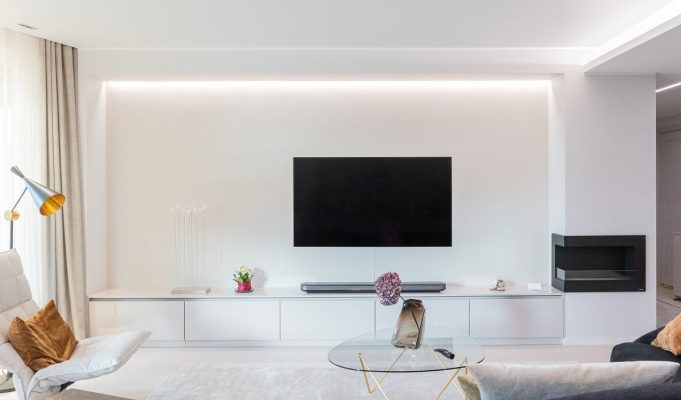
What to consider when choosing the right LED strip power
Factors to consider when choosing the power of a Led strip are:
- Surface materials: light reflects more and dark absorbs light
- Reflection distance: a longer distance means that light is lost on the way
- Led profile cover: the cover smooths beautifully, but eats up light
- Led profile placement: indirectly or directly?
- Desired amount of light: more light is needed for work than for watching TV
When choosing the wattage of an LED strip, it is also important to consider other factors such as the purpose of the lighting and the environment. For example, LED strips used in humid environments should be protected. It is also important to ensure that the power of the strip matches its intended use in order to achieve the desired lighting effect.
Calculating the power of the LED strip
Calculating the power of the LED strip helps you choose the right efficiency for the application. The power calculation is based on the power it consumes in watt-hours per metre. This is usually expressed in Watts per metre or W/m. For example, 7.2 W/m.
How to calculate LED strip power
Calculating the power of an LED strip is easy when you know the power it consumes in watt-hours per metre. Power is calculated by simply multiplying the power consumed by the length of the strip. For example, if the LED strip has a power of 7.2 W/m and a length of 5 metres, the total power consumption of the strip is 36 W.
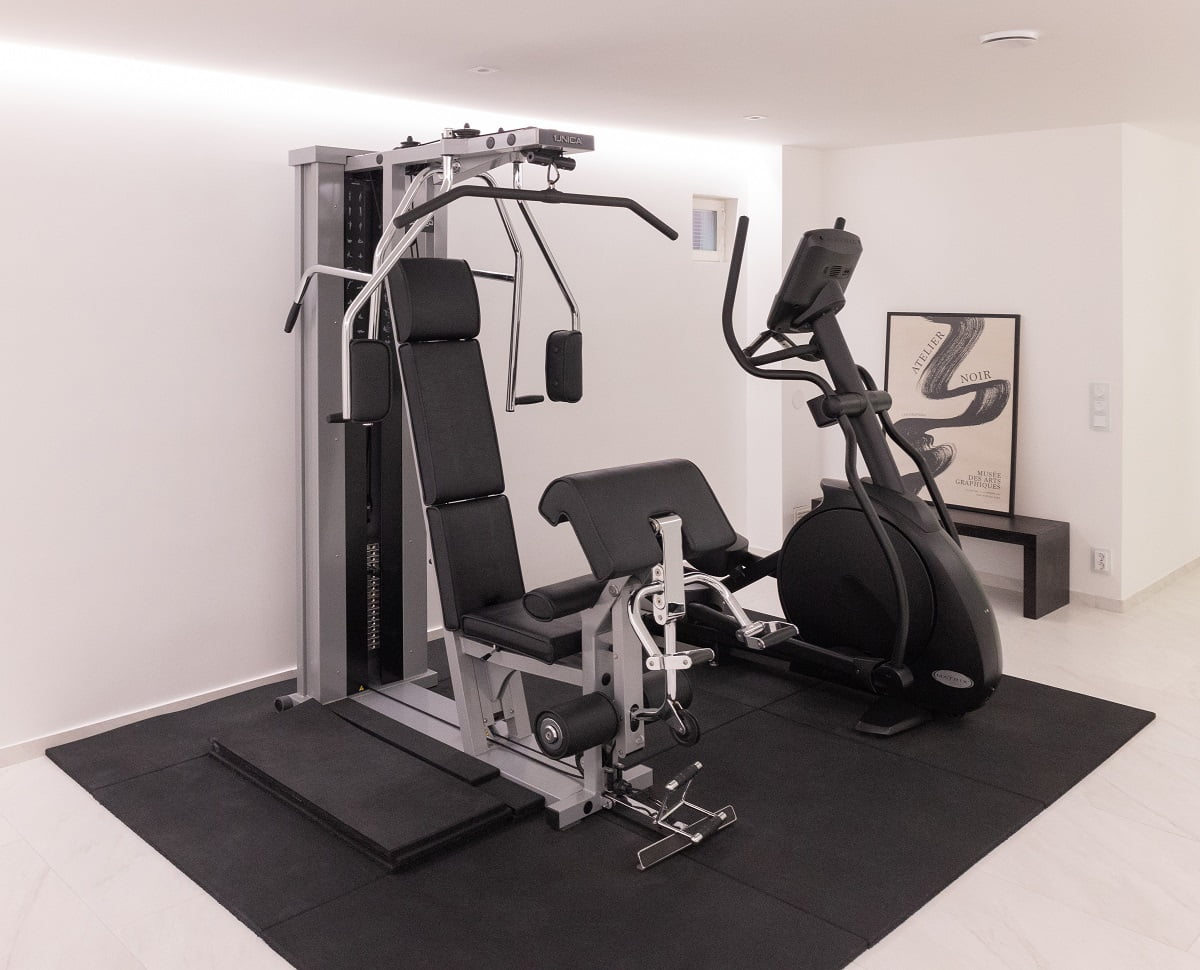
How to measure the power consumed by an LED strip
The power consumed by the LED strip is usually measured by a separate meter connected between the strip and the power supply. The meter measures the power consumed by the tape in watt-hours and helps you choose the right power for the application.
An easier way is of course to measure the driver at the same time and this can be done using n. a 10 € plug-in consumption meter.
If the meter says that the energy consumption is 73 W, and you have 5 meters of led strip, it means that the strip is 14.4 W / m of led strip. 5 x 14.4 W = 72 W + 1 W for the transformer.
What to consider when lowering the power of an LED strip
When lowering the power of the Led strip, the following should be taken into account
- The type of strip, i.e. what kind of strip it is and how many lumens per watt of light.
- Point of use, does the LED strip go hidden (indirect) or is it a target light?
- The transformer should always be left with 10-15% more than the power required by the LED strip.
- Long cables from the transformer to the LED strip provide more resistance and this affects the power requirement.
LED strip applications and their power requirements
There are many applications for LED strip, and each application requires a different strip power. In the following, we will go through the applications of LED strip for indoor and outdoor use and how to choose the right wattage for different applications.
Indoor use of LED strip
The use of LED strip lighting has become increasingly common as a lighting solution for indoor applications in recent years. LED strips can be used to create versatile and atmospheric lighting in the living room, bedroom or kitchen, for example. For indoor lighting, LED strips are generally suitable, with IP21 ratings and wattages ranging from 7-20W per metre. For mood lighting 7W and for work use +20W led strip.
Outdoor use of LED strip
The use of LED strips outdoors has also become more common in recent years. Outdoor lighting usually requires lower wattage LED strips, which are more resistant to weather and humidity than indoor strips. Outdoor lighting can be used to highlight facades, illuminate terraces or balconies, and illuminate paths and stairs, for example.
Outside, 7.2W LED strips are enough to create atmosphere and highlight the edges. If you want more light or if it’s a public place, 14.4W strips and more are suitable.
How to choose the right efficiency for different applications
Choosing the right LED strip efficiency for different applications depends on the lighting need and the destination. For example, a lower wattage strip strip may be sufficient for atmospheric lighting, while a higher wattage strip may be needed for facade lighting, for example. It is important to check each tape you
nal information and choose the appropriate efficiency according to the purpose for which it is to be used.
How to choose the right LED strip power for the application
When choosing the power of an LED strip, it is important to consider the intended use. An indoor strip strip requires different power than an outdoor strip. Different lighting applications also require different power tapes. For example, lighting in the kitchen may require higher wattage than mood lighting in the bedroom. Let’s take a couple of examples:
750-1000Lux required for kitchen worktop
The led strip in the kitchen area should be powerful enough to get to 750 Lux easily, because if the led strip produces 1000Lumen per meter (14,4W and more powerful led strips) we will do well. Things that affect light:
- The reflection distance is approx. 50cm
- The Led strip is installed inside the 20% reducing led profile
- Led profile opens the light at an angle of 110 degrees
Taking all these things into account, the result is around 750 Luxia for the worktop.
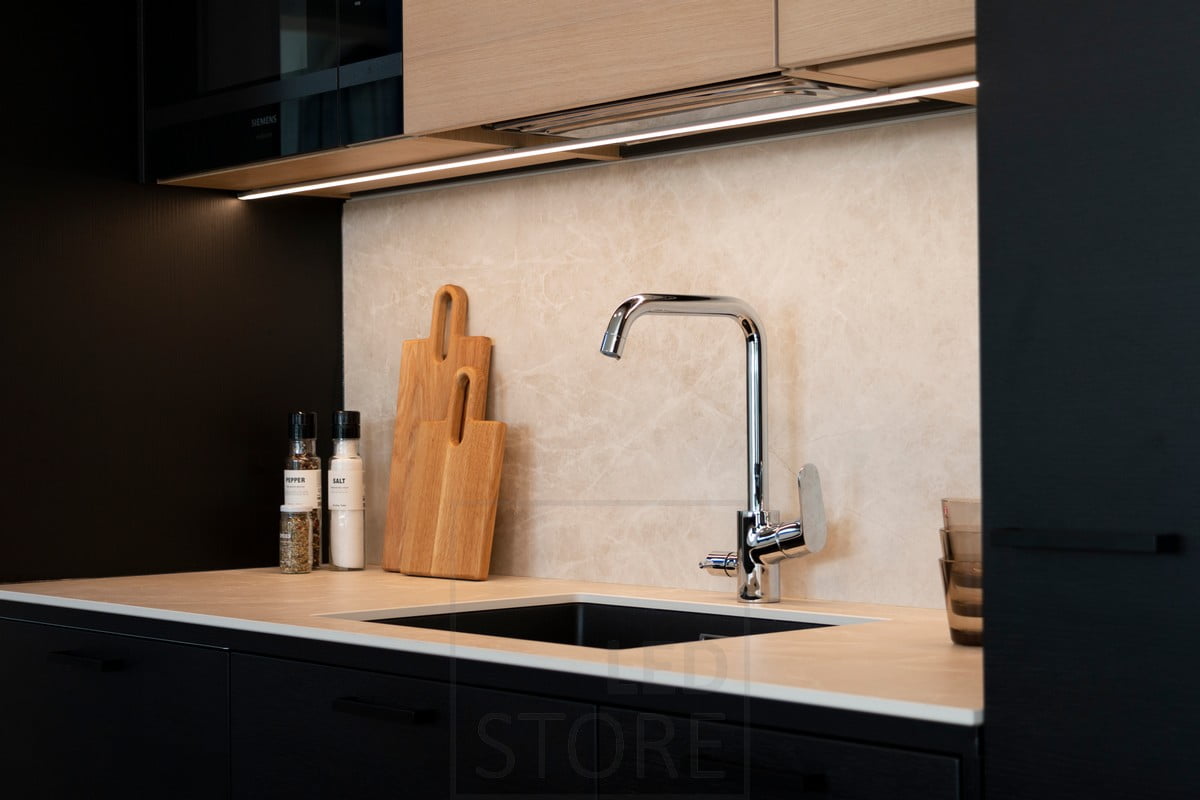
100-200Lux needed for the parents’ bedroom
Achieving 100 Lux mood lighting in a bedroom is possible if the LED strip produces 1000Lumen per metre (14.4W and more powerful LED strips) and the light is indirectly mounted on two walls. Light is affected by:
- Reflection through the wall indirectly at a distance of approx. to the floor 250cm, reduction 20%
- The Led strip is installed inside the 20% reducing led profile
- Indirect light recess opens the light at an angle of 30 degrees + reflections from the wall
Taking all these things into account, around 100 Luxia 1m above the floor in the light area.
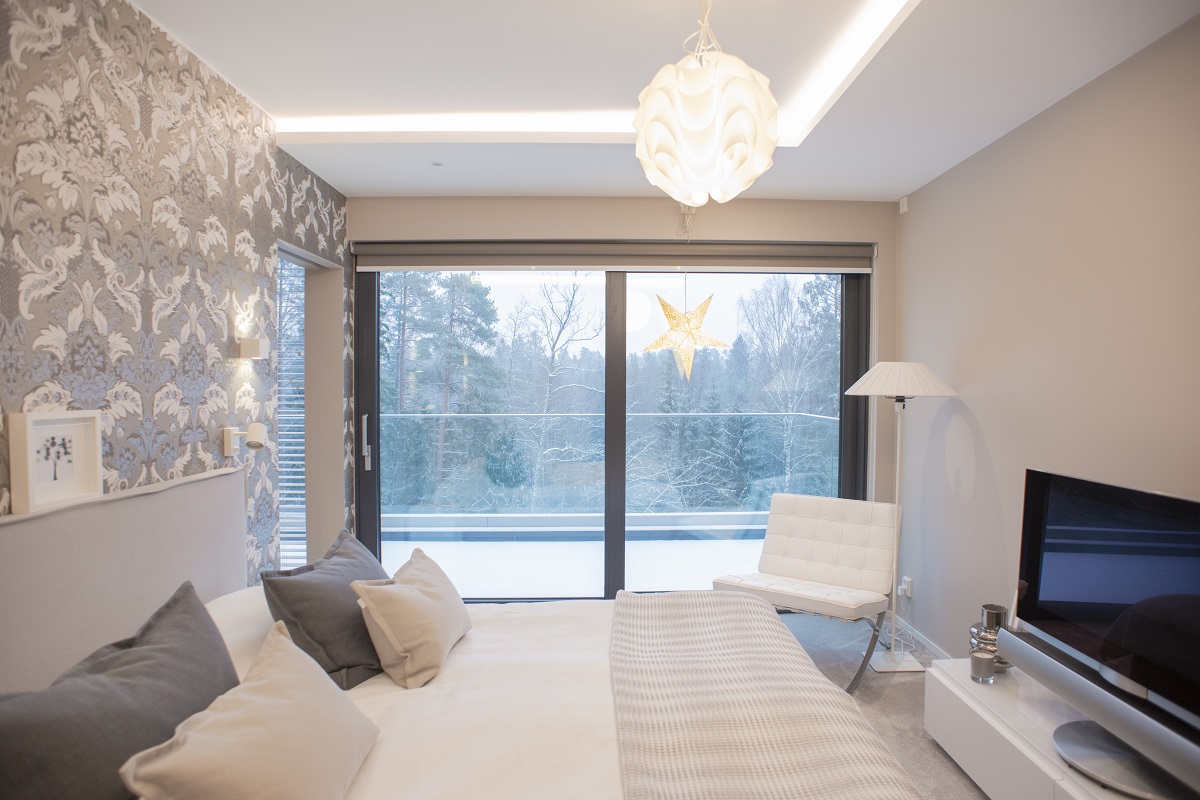
Living room needs 100-200Lux
For a living room with 150 Lux mood lighting, a LED strip with 1000Lumen per metre (14.4W and more powerful LED strips) and indirectly mounted on four walls can be used. In addition, a pendant. Light is affected by:
- Reflection through the wall indirectly at a distance of approx. to the floor 250cm, reduction 20%
- The Led strip is installed inside the 20% reducing led profile
- Indirect light recess opens the light at an angle of 30 degrees + reflections from a light wall
- The 10W bulb of the pendant light produces 1000 lumens around it
Taking all these things into account, around 150 Luxia 1m above the floor in the light area.
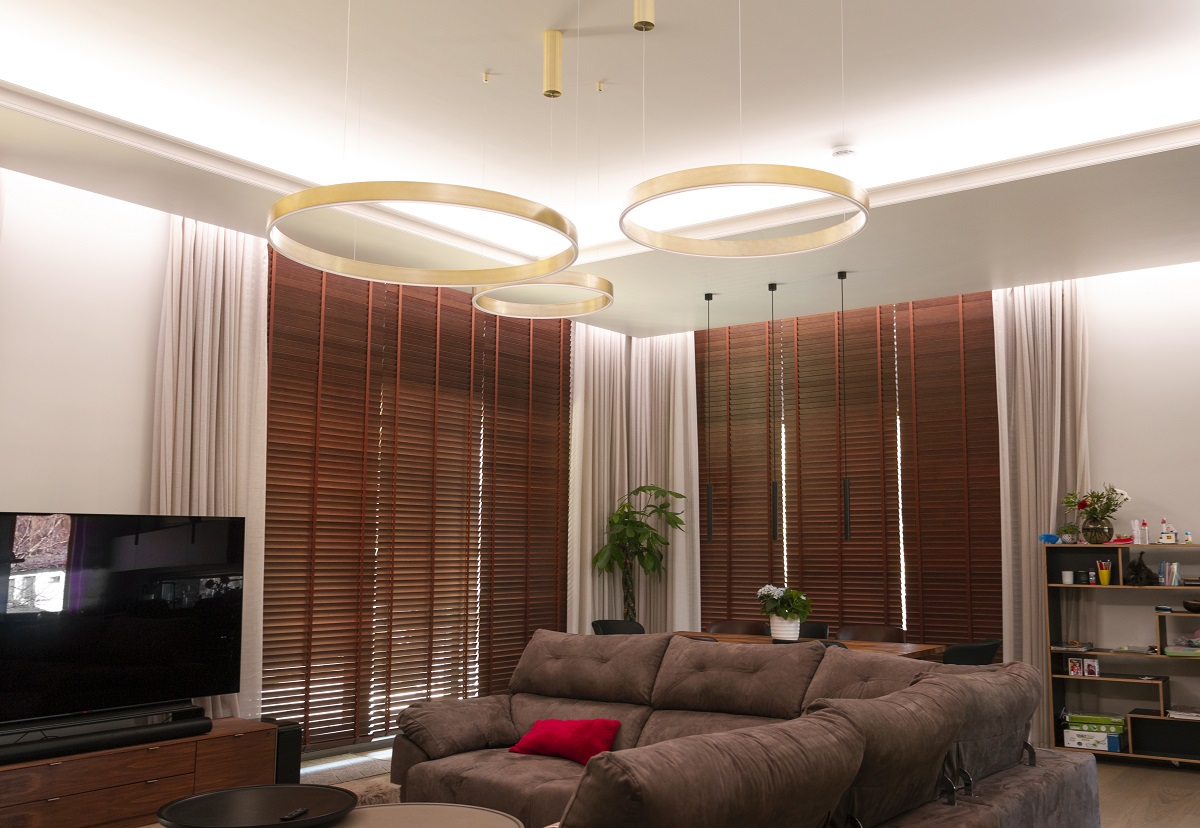
The role of LED strip brightness in lighting
The brightness of the LED strip has a significant impact on the mood and efficiency of the lighting. For example, a brighter ribbon produces a stronger light and can highlight details in the illuminated object, while a dimmer ribbon creates a more atmospheric and softer lighting.
Effect of LED strip brightness on lighting mood
Indeed, the brightness of the LED strip has a major impact on the lighting atmosphere. A brighter ribbon creates a brighter light and may be a good choice for a work space or kitchen, for example. Instead, a dimmer ribbon creates a more atmospheric lighting effect, more suitable for a living room or bedroom, for example.
Measuring the brightness of the LED strip
The brightness of an LED strip is generally measured with a luminometer. The lumen meter measures the total amount of light produced by the LED strip, helping you to choose the right brightness for your needs. When measuring the amount of light at a single point, the unit used is lux.
The role of the power supply in LED strip efficiency
The choice of power supply is an important part of the LED strip selection process. The power supply acts as a power supply for the LED strip and its power affects the efficiency of the strip.
What the power supply does to the LED strip
The power supply supplies the LED strip with the necessary electrical current and ensures its steady operation. Choosing the right power supply is important to ensure that the LED strip works properly and has the power for its intended use.
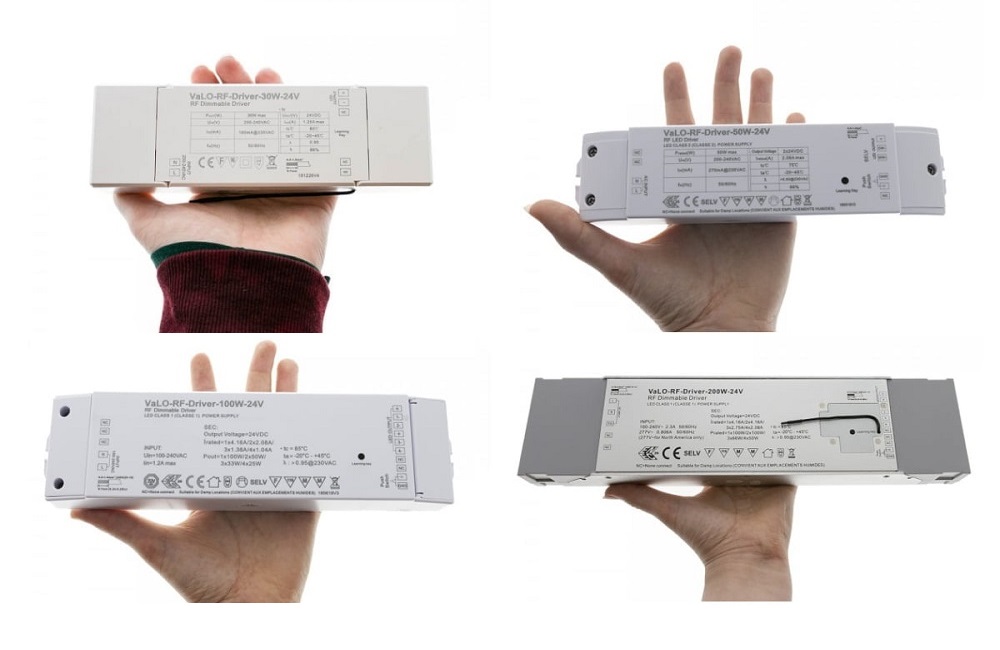
How to choose the right power supply for your LED strip
Choosing the right power supply, i.e. the LED transformer, depends not only on the power and length of the LED strip, but also on the environment in which the strip will be used. For example, a tape power supply for use in damp areas must be protected against moisture and dirt. It is important to check the specifications of the LED strip and choose the appropriate power supply accordingly.
For example if your led strip is 24 V then you will need a power supply that outputs 24 DCV. You should also note that if your LED strip is 14.4 W per metre and you are installing it at 3 metres, the power supply should be 50 – 60 W. So when sizing the power supply, you should make sure that there is a 10 – 15% margin.
What are the important factors when choosing a power supply
When choosing a power supply, its efficiency, protection rating and safety features must be taken into account. A powerful power supply ensures that the LED strip is functional and the power is adequate for its intended use. The protection rating in turn provides assurance that the power supply is protected against external factors such as moisture and dirt.
In addition, safety features such as overheat protection ensure the safe operation of the power supply during use.
How to save energy by choosing the right LED strip wattage
Choosing the right LED strip wattage helps save energy and reduce energy consumption. When the power of the tape matches its intended use, it works optimally and consumes less electricity. This saves energy and can significantly reduce electricity bills.
With dimmer switches, you always get the right amount of light and electricity savings.
How to choose the right LED strip wattage to save energy
The power output of an energy-efficient LED strip depends on its intended use and the environment. For example, in a living room or bedroom, a dimmer tape is more suitable, while a brighter tape is a better choice for a work space. It is essential to choose a tape with a power rating that matches its intended use, in order to keep energy consumption as low as possible.
Why energy saving is important when using LED strip
LEDs are the best technology for home lighting. Saving energy is important when using LED strip, as it reduces energy consumption and helps save the environment. LED strips are energy efficient and consume less electricity than traditional light sources. Choosing the right wattage will help you get the most out of the energy efficiency of LED strips.
Lower wattage LED strips are also longer lasting, due to the lower heat they produce.
LED strip power and durability
The lifetime of the LED strip will influence its choice. A long-life strip can save you money in the long run, while a short-life strip may require more frequent replacements and thus incur extra costs.
LED strip lifetime and its impact on selection
The lifetime of an LED strip depends on its quality and the conditions of use. A long-life strip can last up to 50 000 hours, while a short-life tape may have only a few thousand hours of use. It is important to choose a durable strip and install it correctly, appropriate to its intended use and the environment.
For example, outdoor tapes must be resistant to moisture, temperature fluctuations and UV radiation.
How long will the led strips last? The lifetime of the LED strip is greatly affected by how warm the LED strip gets. A 10 degree change can reduce up to 20,000 hours of LED tape life!
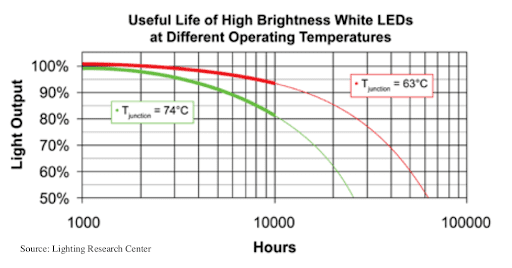
How long-life strip can save you money in the long run
A long-life LED strip can save you money in the long run, as it lasts longer and requires less maintenance and replacement. This reduces maintenance costs and can save significant costs in the long run.
What to consider when choosing the power of an LED strip for outdoor use?
When choosing the power of an LED strip for outdoor use, it is important to consider its intended use and the environment. Tapes for outdoor use must be resistant to moisture, temperature fluctuations and UV radiation. It is important to check the specifications of the tape and ensure that its performance matches its intended use and the environment.
Different outdoor applications and their power requirements
Different outdoor applications may have different power and durability requirements. For example, a strip for lighting an outdoor staircase may have a lower wattage than a strip for a patio or outdoor space. It is important to choose a strip that matches its intended use and environment.
How to choose the right LED strip wattage to ensure durability and lighting performance
Choosing the right LED strip wattage to ensure durability and lighting performance depends on its intended use and environment. So let’s remember the basics. If the LED strip is really powerful, over 14 W per metre, it should ALWAYS be mounted in a thermally conductive material to make it last.
Lower power LED strips may otherwise withstand outdoor use without aluminium, but then comes UV radiation and natural conditions. That is, the installation of aluminum also provides protection.
LED strip wattage and colour temperature – how to choose?
Colour temperature is an important selection factor when choosing LED strips. The differences between warm and cool white tones affect the mood and atmosphere of the lighting. It is important to choose the right colour temperature and wattage to achieve the desired lighting effect.
Temperature-controlled CCT LED strips are always lower luminous intensity than monochrome ones, as the power is shared between different coloured LED circuits.
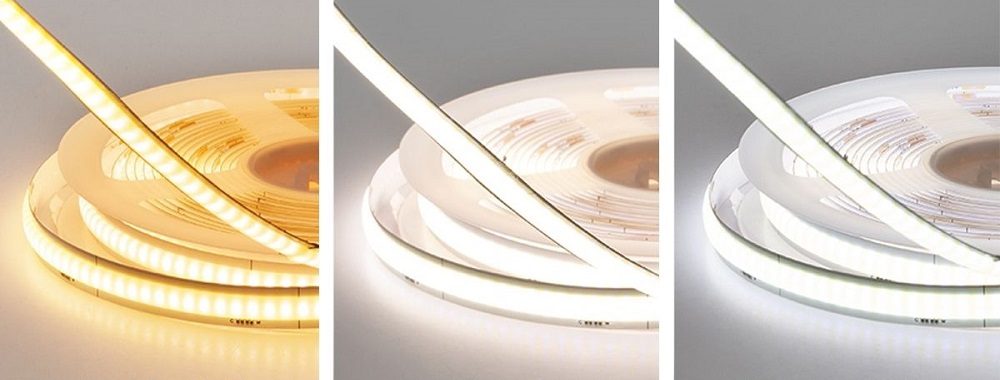
Why colour temperature is an important selection factor when choosing LED strips
The colour temperature has a significant impact on the mood of the lighting. A warmer shade of white creates a softer, cosier feel, while a cooler shade of white creates a brighter, more refreshing atmosphere. It is important to choose the right colour temperature depending on the atmosphere you want to create.
The differences between warm and cool white shades and their uses
A warmer shade of white is better suited to relaxation and comfort spaces such as the living room and bedroom.
A cooler shade of white is better suited to workspaces and more active areas such as kitchens and bathrooms.
The temperature-adjustable LED strip adjusts according to the situation.
How to combine the right colour temperature and wattage to achieve the desired lighting effect
Matching the right colour temperature and wattage is important to achieve the desired lighting effect. So choose a strip with a colour temperature and output that matches its intended use and environment. You can also always opt for a temperature-controlled LED strip that allows you to choose the right shade for the situation.
Summary
LED strip lighting is popular for creating atmospheric and energy-efficient lighting indoors and outdoors. The power, brightness, duration and colour temperature of the LED strip must be carefully selected taking into account its intended use and environment.
The choice of wattage affects the performance, energy consumption and durability of the strip, while the brightness determines the mood of the lighting. The choice of colour temperature, in turn, affects the lighting atmosphere.
It is important to look at the specifications of the tape and choose the one that best suits its purpose and environment. With LED strips, you can create spectacular and energy-efficient lighting solutions for your home or business premises.
LED strip specialist
LedStore has been an expert in led lighting since 2010. We have our own product design, so our products are technologically state-of-the-art.
We focus on light colour temperature controlled and high colour rendering index lights. We do around 500 lighting designs in a year.
We offer a service of custom made led strips, i.e. custom made led light strips in profile. Also installed.
Remember that we are always ready to offer our help to you along the way, by email (myynti@ledstore.fi) and by phone (045 251 4510).
As always, feel free to share photos of your own projects on social media at ledstore.fi at Instagram and ledstore.fi at Meta. We love to see the cool things done by our LEDs, and it also helps to provide inspiration for those who are not sure about the power and awesomeness of LEDs. Did you know that we already have over 3 500 pictures of our LED installations in our Gallery!
Led Lights Gallery:
Product gallery: Pictures of products in different installation locations
Indirect light: Indirect light in different spaces
Room-specific: Light in different rooms
References: Complete houses that have been photographed

